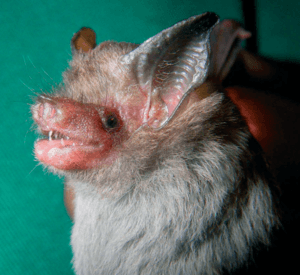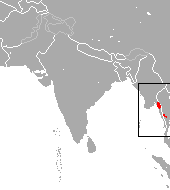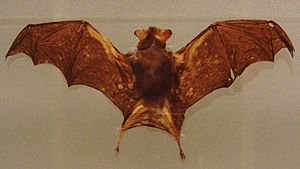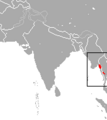Kitti's hog-nosed bat facts for kids
Quick facts for kids Kitti's hog-nosed batTemporal range: Recent
|
|
|---|---|
 |
|
| Conservation status | |
| Scientific classification | |
| Genus: |
Craseonycteris
|
| Species: |
thonglongyai
|
 |
|
| Kitti's hog-nosed bat range | |
The Kitti's hog-nosed bat (Craseonycteris thonglongyai), also called the bumblebee bat, is a tiny bat that is an endangered species. It is the only member of its special family, Craseonycteridae. You can find this bat in western Thailand and southeast Burma. It usually makes its home in limestone caves near rivers.
This bat is the smallest bat species in the world. It is also one of the smallest mammals on Earth! It has fur that is reddish-brown or grey. A special feature is its pig-like snout. Bat groups, called colonies, can have different sizes. On average, about 100 bats live together in one cave. The Kitti's hog-nosed bat hunts for insects in nearby forest areas. It flies for short times in the evening and at dawn. Female bats have only one baby each year.
Contents
What is the Kitti's Hog-Nosed Bat?
The Kitti's hog-nosed bat was first discovered in 1974. It is the only living species in its unique family, Craseonycteridae.
How Does the Kitti's Hog-Nosed Bat Look?
The Kitti's hog-nosed bat is very small. It is about 29 to 33 millimetres (1.14 to 1.30 inches) long. This is about the size of a bumblebee! It weighs around 2 grams (0.07 oz). This makes it the smallest bat species. Another tiny mammal, the Etruscan shrew, can be even lighter.
This bat has a unique, swollen snout that looks like a pig's nose. Its nostrils are thin and point upwards. The bat's ears are quite large, but its eyes are small and often hidden by its fur. Its teeth are perfect for eating insects.
The Kitti's hog-nosed bat has large, dark wings. The tips of its wings are long, which helps the bat hover in the air. It does not have a visible tail. There is a large web of skin between its back legs. This skin might help it fly and catch insects. However, there are no tail bones to help it steer.
Where Does the Kitti's Hog-Nosed Bat Live?
In Thailand, these bats live in a small area of Kanchanaburi Province. This area is near the Khwae Noi River.
In 2001, one bat was found in Burma. Since then, at least nine more places where they live have been found there. The bats in Thailand and Burma look the same. However, their echolocation calls (the sounds they make to find things) are different. Scientists are not sure if the two groups can have babies together.
How Does the Kitti's Hog-Nosed Bat Behave?
Kitti's hog-nosed bats sleep in caves found in limestone hills. These caves are usually along rivers, inside dry evergreen or deciduous forests. Many caves have only 10 to 15 bats. But on average, a group has about 100 bats. Some large groups can have up to 500 bats! The bats sleep high up on cave walls or ceilings. They stay far apart from each other. These bats also move between different caves during certain seasons.
Daily Activities
The Kitti's hog-nosed bat is active for only a short time each day. It leaves its cave for just 30 minutes in the evening. It also flies for 20 minutes at dawn. Heavy rain or cold weather can stop these short flights. During these flights, the bat hunts for food. It flies over fields of cassava and kapok. It also hunts around the tops of bamboo plants and teak trees. They usually stay within one kilometre of their sleeping cave. Their wings seem to be shaped for hovering in the air.
Reproduction and Life Cycle
Late in the dry season, around April, female bats give birth. Each female has only one baby. When the mother goes out to find food, her baby either stays in the cave or holds onto her. The baby attaches to one of her two small, non-working nipples near her back legs.
What Do Kitti's Hog-Nosed Bats Eat?
Their main food is small flies. But they also eat other insects and creatures. These include spiders, beetles, wasps, and lice.
Who Hunts the Kitti's Hog-Nosed Bat?
The main predators of the Kitti's hog-nosed bat in the wild are snakes, squirrels, birds, and cats.
Why is the Kitti's Hog-Nosed Bat Endangered?
The IUCN listed the Kitti's hog-nosed bat as endangered in 1996. This means its population is decreasing.
The biggest threat to the bats in Thailand is the yearly burning of forest areas. This happens most often when the bats are having their babies. Also, a plan to build a pipeline from Burma to Thailand might harm them. We don't know much about the threats to the bats in Burma.
In 2007, the EDGE project chose this bat as one of its top 10 "focal species." EDGE stands for "evolutionarily distinct and globally endangered." This means the bat is very unique and needs special help to survive.
Images for kids
See also
 In Spanish: Murciélago moscardón para niños
In Spanish: Murciélago moscardón para niños





